![]()
![]()
![]()
Use LEFT and RIGHT arrow keys to navigate between flashcards;
Use UP and DOWN arrow keys to flip the card;
H to show hint;
A reads text to speech;
50 Cards in this Set
- Front
- Back
|
Homeostasis |
Body's attempt to adjust to fluctuating environment to return to the norm |
|
|
Three components of control system |
Monitor, coordinating center, regulator |
|
|
Negative feedback system |
Mechanisms that make adjustments to restore homeostasis, prevent small changes from becoming large. Example. Carbon dioxide levels rise, sensors are stimulated, control center relays info to brain, regulator sends impulse to muscles to increase depth and rate of breathing |
|
|
Positive feedback system |
Process where controlled variable is moved away from homeostasis. Allows physiological event to be accomplished rapidly for example labour |
|
|
Thermoregulation |
Negative feedback mechanism. Stimulus is the skin, control centre is hypothalamus, receptor is skin. |
|
|
Vasodilation |
When body is too hot blood vessels at the surface of the skin dilate and blood moves to surface, so heat is radiated away from the body. |
|
|
Vasoconstriction |
Surface blood vessels constrict when temperature is low, keeps blood close to core. |
|
|
Function of the CNS |
Central nervous system acts as a coordinating center |
|
|
Function of PNS |
Peripheral nervous system carries info to and from CNS |
|
|
Parts of the PNS |
Somatic and Autonomic |
|
|
Parts of the nerve cell |
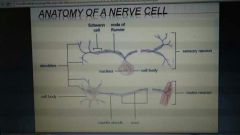
Dendrites, Schwann cell, node of ranvier, sensory neuron, cell body, nucleus, motor neuron, axon,myelin sheild |
|
|
Glial |
Neurological cells, non conducting support structure |
|
|
Neuron groups |
Sensory, interneurons, motor neurons |
|
|
Sensory neurons |
Sense and relay info from environment to CNS. Located in clusters called Ganglia |
|
|
Interneurons |
Link neurons within the body. Integrate and interpret sensory information and connect neurons to motor neurons |
|
|
Motor neurons |
Relay information to effectors |
|
|
Effectors |
Muscles, organs, glands, effectors as they produce responses |
|
|
How is the neuron signal relayed |

Message moved from dendrite, through nerve body to axon. Travels through the mylein sheath, jumping between the nodes of ranvierm |
|
|
Anatomy of the neuron |

|
|
|
Nervous system that surrounds nerve fibers |
Neurilemma |
|
|
Function of neurilemma |
Promotes regeneration of damaged axons |
|
|
Difference between white matter and grey matter |
White matter contains mylein and neurilemma, grey matter does not. |
|
|
What is MS a disease of? |
Destruction of myelin sheath |
|
|
Mylelin sheath |
Insulting fatty later that speeds transmission |
|
|
Axon |
The conducting fiber |
|
|
Schwann Cells |
They make myelin |
|
|
Dendrites |
Receivers |
|
|
Axon terminals |
Transmitters |
|
|
5 components of a reflex arch |

Receptor (senses something) Neuron (sends signal to the CNS) Interneuron (registers signal) Motor neuron (sends response back) Effector (carries out the action) |
|
|
What is membrane potential |
The cytoplasmic side of the membrane (inside the cell) is negative to the extracellular side. This charge separation is a form of potential energy. |
|
|
What is resting membrane potential |
Potential difference across a membrane in a resting neuron (-70 mV) provides energy for generating a nerve impulse. The process of generating a resting membrane potential of -70mV is called polarization |
|
|
Process of the Sodium-Potassium Pump |
1. Carrier protein has a shape that allows it to take up 3 sodium ions from the inside of the cell 2. ATP is split and a phosphate group is transfered to the carrier protein changing its shape, which allows it to release the sodium ions and take in two potassium ions. 3.The phosphate group is released which changes the shape once more allowing the potassium to be released. |
|
|
What is depolarization and how does it occur? |
Depolarization is when membrane potential is reduced to less than -70mV. During depolarization the inside of the cell becomes less negative relative to the outside of the cells. Depolarization occurs because of an action potential |
|
|
What is action potential? |
Action potential is the movement of an electrical impulse along the plasma membrane of an axon. |
|
|
What is threshold potential? |
The level an axon must depolarize for an action potential to occur. Close to -50mV |
|
|
Path of action potential |

|
|
|
Step 1 of Action Potential |
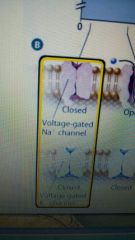
An action potential is triggered when the threshold potential is reached |
|
|
Step 2 of Action Potential |
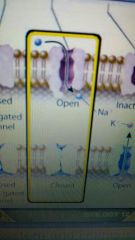
Voltage gated sodium channels open when the threshold potential is reached. Sodium ions move down their concentration gradient and rush into the axon and depolarize the membrane. +40mV |
|
|
Step 3 of action potential |
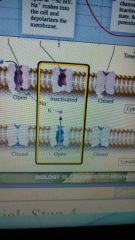
Voltage gated sodium channels close due to change in membrane potential. Voltage gated potassium channels open. Potassium ions move down their concentration gradient and exit the axon. -90mV |
|
|
Step 4 of action potential |
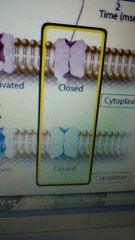
Voltage gated potassium channels close. The sodium potassium pump and naturally occurring diffusion restore the resting membrane of -70mV. The membrane is repolarized. |
|
|
What is the refractory period? |
The period after action potential occurs where the membrane cannot be stimulated. |
|
|
Signal transmission across a synpase step 1 |
The nerve impulse travels to the synaptic terminal |
|
|
Signal transmission across a synpase step 2 |
Synaptic vesicles containing neurotransmitters move toward and fuse with the presynaptic membrane. |
|
|
Signal transmission across a synpase step 3 |
Synaptic vesicles release neurotransmitters into the synaptic cleft by exocytosis. Neurotransmitters diffuse across the synapse to reach the post synaptic neuron or the cell membrane of an effector |
|
|
Signal transmission across a synpase step 4 |
Neurotransmitters bind to specific receptor proteins on the postsynaptic membrane the receptor protein trigger ion channels to open. Depolarization of the post synpatic membrane occurs and an action potential is initiated if the threshold potential is reached. |
|
|
Function of serotonin |
Regulated temperature and sensory perception. Is involved with mood control. |
|
|
Function of endorphins |
Act as natural painkillers, also emotional areas of the brain |
|
|
What are the glands in the endocrine system? |
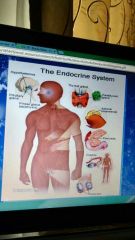
|
|
|
Steriod hormone action |
1. Hormone diffuses from cell into blood 2. Diffuses into the cells of target tissue 3. Attached to receptor molecule in cytoplasm 4. Hormone receptor complex enters nucleus 5. Hormone complex activayes transcription of a particular gene to induce hormone effect |
|
|
Peptide hormone action |
1. Hormone released from cell vesicles into blood 2. Attached to a receptor on the exterior of the cell and membrane of target cells 3. HR complex triggers production of cAMP 4. cAMP triggers a specific enzyme cascade to induce hormone effect |

